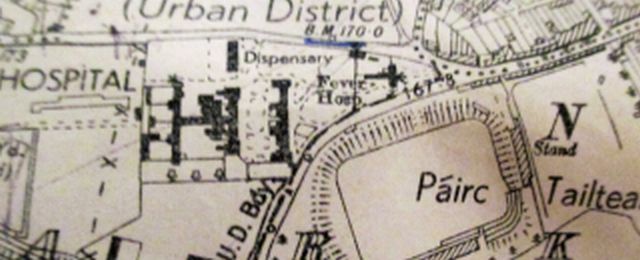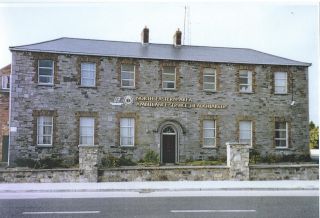Navan Fever Hospital

The Fever Hospital was located within the hospital grounds facing towards Brews Hill. It was erected in Navan in 1818. It had 4 wards each capable of holding 10 beds.
In 1832 a cholera epidemic swept through Navan. On 24th August 1832 the Navan Health Board was set up under the chairmanship of Fr. Eugene O'Reilly. It applied for a grant of £170 from the Central Board to help deal with the crisis. The grants were usually matched pound for pound by local contributions. Houses were disinfected by whitewashing them. Dunghills were removed. The grant of £170 was granted in Sept 1832. The grant states "after the first week from the appearance of cholera the Board in Navan had paid but one physician weekly."
It was recorded that Fr Ennis the Navan curate, was occupied from morning to night during the cholera epidemic. Cholera struck again in the summer of 1849, spreading inland from the port of Drogheda. Navan had 38 cases and 16 deaths.
The information below is from the Meath Chronicle archives :
Navan Board of Guardians: A report was read from the docor that there were 20 cases in the Fever Hospital - 17 being measles. It was mentioned that the schools were all closed. (14th March 1914)
One case of scarletina reported in the Fever Hospital. The Master reported that Sir Nugent Everard and the Hon. Mrs Collins had sent in apples for the inmates. (Oct 1914)
Dr. Finnegan reported to the Navan Board of Guardians that there was 1 case of mumps, 4 of influenza and 1 of scarletina in the Fever Hospital. (13 March 1915)
A boy named Edward White, who was admitted a few weeks ago to Navan Fever Hospital, is doing well under the care of Dr Drummond who is deputising for Dr. Finnegan. The boy was chasing rabbits at Dunshaughlin, when on putting his hand into a burrow, he was bitten by a rat. The wound looked very bad, but under Dr. Drummand's skillful treatment it has begun to heal. The doctor is the son of County Court Judge Drummond. Meath Chronicle 14 April 1915
On 5 June 1915, the Meath Chronicle reported that there were 4 cases of scarletina and 4 cases of influenza in the Fever Hospital.
Irish Independent, 25 Oct 1918 - The Flu Pandemic hits Navan
Several deaths have occcured around Navan. The Master of the Workhouse reported to the Guardians that the Fever Hospital was crowded with patients, 23 being influenza, 3 diptheria and 4 scarletina. Both nurses were ill and he could get none from Dublin.
*******
More from the Meath Chronicle archives:
The Meath Chronicle in 1922, reported that a trained Fever Nurse had been employed in Navan at a salary of £80 p.a. and also a female attendant at £30. In 1936, the Chronicle reported that scarletina was prevalent in the town and several patients had been admitted to the Fever Hospital.
Two cases of Infantile Paralysis which were admitted to the Fever Hospital, were recorded by the Chronicle in 1942.
The Fever Hospital closed its doors in
1956, and today the
Fever Hospital building houses
Navan's Ambulance Service.
(pictured left)
The Tablet, 17 February 1849
NAVAN. — THE LATE MR. A. NICOLLS. — On the eve of last Christmas Day, the late Mr. Arthur Nicolls, medical assistant at Navan Fever Hospital, having died of an attack of cholera, was interred in Glasgow, where but one week previously he entered college to complete his studies in physic and surgery.
On the 8th instant, in the Roman Catholic Church of the Assumption, Navan, his Month's Mind took place, and a solemn High Mass was offered up for his soul. The Right Rev. Dr. Cantwell, with twenty-one of his Clergy, and an English Priest, the Rev. James Sheridan, attended the solemn offices. There was a numerous attendance of clergymen and parishioners on the occasion. Rev. Edward Flinn, Navan, Celebrant; Very Rev. Nicholas M'Evoy, Kells, Deacon; Rev. Robert Mullen, Clonmellon, Subdeacon; Reverend Michael Coghlan, Cullianstown, Master of the Ceremonies; Very Rev. Eugene O'Reilly, Navan; Rev. Messrs. Nicholas Power, Patrick Horan, &c. &c., were present. The attainments of the deceased were of no ordinary class, and his professional capabilities in particular were of high promise. To the afflicted poor of this locality his loss is irreparable. — Drogheda Argus.
Sources:
Navan by the Boyne, Noel French, 2002
The Land and People of County Meath 1750-1850, Peter Connell, (2004) pp. 225
Newspaper Archives